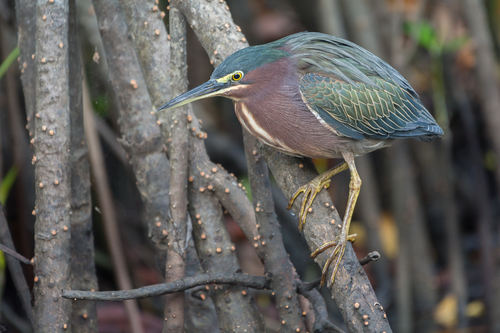
Green Heron
The Green Heron (Butorides virescens) is a small, stocky heron found throughout much of North and Central America, as well as parts of the Caribbean. It is known for its striking, yet subtle, coloration and its clever use of tools for hunting. Unlike some of its larger heron relatives, the Green Heron often prefers dense vegetation along the edges of wetlands, making it a less conspicuous, but no less fascinating, inhabitant. Ecologically, it plays a role in controlling populations of small fish, amphibians, and invertebrates. It holds no particular widespread cultural significance, but its unique hunting behavior has made it a subject of interest for birdwatchers and researchers alike.
40-48 cm
Length
62-70 cm
Wingspan
Least Concern
Conservation Status
Distribution
The Green Heron's range extends from southern Canada, through the United States, Mexico, and Central America, to Panama and the Caribbean islands. Some populations are migratory, with northern birds moving south for the winter. They can be found at elevations from sea level to moderate altitudes.
Lifespan
The average lifespan in the wild is not well-documented, but is estimated to be around 8 years. Captive individuals may live longer.
Green Heron's Habitat
Habitat Types
Freshwater marshes, Mangrove swamps, Salt marshes, Riverbanks, Lake edges, Ponds
Climate Zones
Temperate, Subtropical, Tropical
Adaptations
Green Herons have relatively short legs compared to other herons, which is an adaptation for navigating dense vegetation. Their sharp bills are well-suited for spearing prey in shallow water. They also possess specialized neck muscles that allow for rapid strikes.
Variations
Several subspecies are recognized, differing slightly in size and plumage coloration. For example, *Butorides virescens anthonyi* is found in the southwestern US and Mexico, and tends to be paler than the nominate subspecies.
Appearance
Breeding Plumage
Breeding adults have a glossy, greenish-black cap, a chestnut-colored neck and breast with white streaks, and gray-blue wings. Non-breeding adults and juveniles have duller plumage, with more brown and less contrast.
Seasonal Feather Changes
Plumage is generally brighter during the breeding season.
Sex Based Plumage Differences
Males and females have similar plumage, although males may be slightly brighter during the breeding season.
Notable Features
Greenish-black cap, Chestnut neck with white streaks, Relatively short, yellow or orange legs (legs can turn bright orange during breeding season), Sharp, pointed bill
Diet and Feeding
Primary Foods
Small fish, Frogs, Crustaceans, Insects, Snails, Leeches
Foraging Behavior
Green Herons are patient hunters, often standing still or slowly stalking prey at the water's edge. They are known for their use of bait, dropping small objects (e.g., insects, feathers, twigs) onto the water's surface to lure fish.
Specializations
Their specialized neck vertebrae and musculature allow for a rapid, darting strike to capture prey. Their bill is perfectly adapted for grabbing or spearing slippery prey.
Seasonal Diet Variations
Diet may vary depending on prey availability. During times of insect abundance, they may consume more insects. In colder months, fish may become a more significant part of the diet.
Behavior
Social Structure
Green Herons are generally solitary outside of the breeding season, although they may congregate in small groups at good feeding locations. They are considered territorial, especially during breeding.
Communication
A variety of calls, including a loud "skeow" alarm call, A series of "kuk-kuk-kuk" calls during courtship, Soft croaking sounds near the nest
Migration
Northern populations are migratory, flying south to warmer regions for the winter. The timing and extent of migration vary depending on weather conditions and food availability. They often migrate at night.
Territorial or Group Behaviors
During the breeding season, Green Herons defend their nesting territory from other herons and potential predators. They may also defend feeding territories, especially in areas with limited resources.
Conservation
Threats
Habitat loss and degradation (wetland drainage and development), Pollution (pesticides and other contaminants), Climate change (altering wetland habitats and prey availability)
Protection Programs
The Migratory Bird Treaty Act (in the US), Wetland conservation and restoration initiatives, Monitoring programs to track population trends
Local National Laws
Protected under various state and federal laws in the United States and Canada. International treaties protect migratory birds.
Population Trend
Stable
Population Estimates
The global population is estimated to be around 3.2-3.7 million individuals.
Interesting Facts
Green Herons are one of the few bird species known to use tools.
They use bait, such as insects or feathers, to lure fish within striking range.
They can extend their necks to a surprising length when hunting.
This allows them to strike quickly and accurately at prey.
Green Herons sometimes nest in loose colonies.
While generally solitary, they may nest near other Green Herons if suitable nesting sites are limited.
Green Herons will sometimes eat leeches.
While many birds will avoid leeches, the Green Heron has no problems making a meal out of them.
Faqs about Green Heron
What is the difference between a Green Heron and a Great Blue Heron?
Green Herons are much smaller than Great Blue Herons, with different coloration (chestnut and green vs. blue-gray). Great Blue Herons are also less likely to be found in dense vegetation.
Are Green Herons endangered?
No, Green Herons are classified as Least Concern by the IUCN, meaning they are not currently considered to be at risk of extinction.
Where can I see a Green Heron?
Green Herons can be found near freshwater wetlands, ponds, lakes, and rivers throughout their range. Look for them perched on low branches or vegetation near the water's edge.
Do Green Herons make any sounds?
Yes, they have a distinctive "skeow" call, often given when startled. They also make other vocalizations, especially during the breeding season.
Copyright @ Nature Style Limited. All Rights Reserved.
 English
English